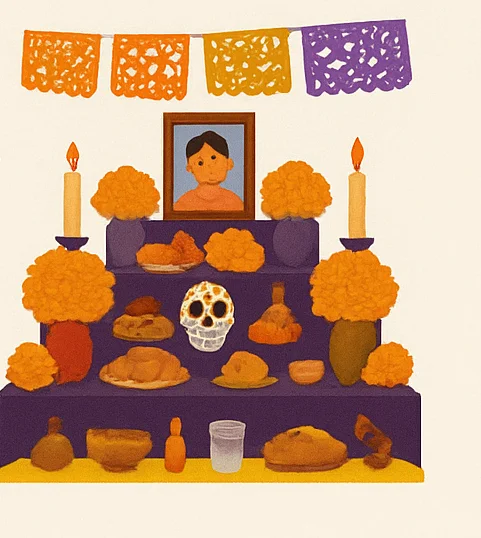Meaning of Ofrendas
An ofrenda (Spanish for “offering”) is a central element of Día de los Muertos (Day of the Dead) celebrations in Mexico and other parts of Latin America. It is an altar or display created to honor and welcome the souls of loved ones who have passed away. The belief is that during Día de los Muertos (November 1st & 2nd), the spirits return to visit, and the ofrenda provides them with the things they enjoyed in life—along with symbols of love, respect, and remembrance.
Ofrendas are deeply spiritual, but they are also an artistic and cultural expression that connects family, tradition, and memory.
Common Elements of an Ofrenda
Each item placed on an ofrenda has a special meaning. While the style can vary by region and family, these are the most traditional elements:
-
Photographs – Pictures of the loved ones being honored.
-
Candles (Velas) – Light the way for the spirits to find their way back home.
-
Marigolds (Cempasúchil) – Bright orange/yellow flowers that guide spirits with their color and scent.
-
Pan de Muerto – A special bread baked for the occasion, symbolizing the cycle of life and death.
-
Food and Drinks – The favorite dishes, fruits, or beverages of the departed (sometimes tequila, mezcal, coffee, or atole).
-
Sugar Skulls (Calaveras de Azúcar) – Represent the sweetness of life and the playful acceptance of death.
-
Incense (Copal) – The smoke cleanses the space and helps spirits find their way.
-
Water – Quenches the thirst of spirits after their long journey.
-
Salt – Purification and protection for the spirits.
-
Papel Picado – Brightly colored cut paper that represents the fragility of life and the union between life and death.
-
Personal Belongings or Mementos – Items that were meaningful to the person in life (musical instruments, clothing, books, toys for children).
-
Crosses or Religious Items – For families who blend Catholic and Indigenous traditions.
Some ofrendas are built on three levels to represent heaven, earth, and the underworld—or on seven levels, representing the stages souls must travel to reach spiritual peace.


My mom mentioned that you might have an ofrenda class this month. I would love more information if this is upcoming. Thank you!
Yes, I’ll email you at jessmariebryant@gmail.com